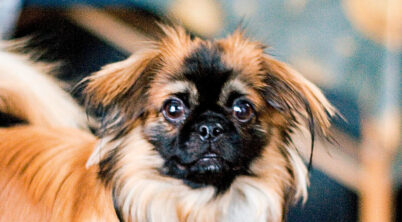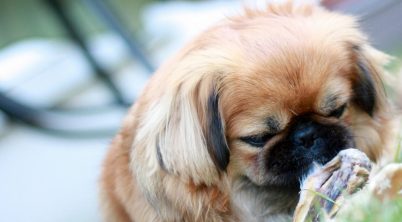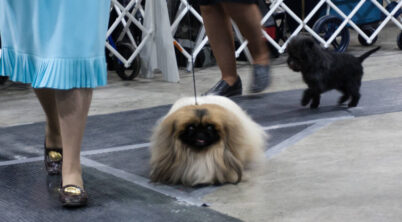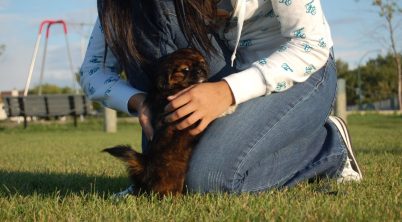Kennel cough is a highly contagious respiratory disease in dogs, akin to a chest cold in humans. Pekingese dogs, with their compact, flat-faced (brachycephalic) structure, can be particularly susceptible to this condition. Characterized by a strong, persistent cough that can often end in gagging, kennel cough manifests due to inflammation of the upper respiratory tract, which includes the trachea and bronchi.
Vaccination is key in prevention, but respiratory infections can still occur in vaccinated dogs, especially when they are under stress or exposed to crowded conditions, such as those found in boarding facilities. In Pekingese, the symptoms of kennel cough need careful monitoring due to their unique respiratory anatomy, which can make them more prone to complications.
Prompt veterinary care is important when a Pekingese shows signs of kennel cough. While many cases may resolve without serious complications, the veterinarian can offer treatment options that mitigate symptoms and reduce the risk of progression to more severe respiratory issues, such as pneumonia. Owners should monitor their dogs closely for the common signs of coughing, lethargy, and loss of appetite, all of which can point to kennel cough.
Understanding Kennel Cough
Kennel cough in Pekingese and other dogs is a common and highly contagious respiratory disease. This section provides a detailed understanding of its causes and symptoms.
Causes and Contagion
Kennel cough, known scientifically as infectious tracheobronchitis, is caused by various pathogens, the most common being the Bordetella bronchiseptica bacteria. It can also involve viruses such as the canine influenza virus and canine adenovirus. The disease is highly contagious and can spread in places with high dog populations, such as kennels and dog parks, through airborne droplets, direct contact, or contaminated surfaces.
- Transmission Methods:
- Airborne droplets from coughing or sneezing
- Direct contact with infected dogs
- Contaminated surfaces (e.g., water bowls, toys)
- Pathogens Commonly Involved:
- Bacteria: Bordetella bronchiseptica
- Viruses: Canine influenza virus, canine adenovirus
Symptoms of Kennel Cough
Infected dogs show a range of symptoms, the most distinct being a persistent and forceful cough. It often has a characteristic “honking” sound and may be followed by gagging. Other symptoms may include sneezing, runny nose, lethargy, and in some cases, fever.
- Common Symptoms:
- Coughing: Dry, hacking sound; may end with a gag
- Sneezing
- Runny Nose
- Lethargy
- Fever (less common)
A dog with kennel cough may appear as if it is trying to clear something from its throat and exhibit signs of general respiratory distress. These symptoms can be exacerbated by excitement or exercise. While some dogs with kennel cough may not display severe symptoms, others, especially young puppies, older dogs, or those with existing health problems, can develop complications such as pneumonia.
Diagnosis and Treatment
When a Pekingese shows signs of respiratory distress, it’s essential to accurately diagnose the condition and provide effective treatment. This approach ensures the dog regains its respiratory health and comfort.
Diagnosing Kennel Cough
A veterinarian typically begins the diagnosis of kennel cough by examining the dog’s symptoms, which often include a persistent and forceful cough with a “honking” sound. They will assess the dog’s recent history to rule out other illnesses and may perform various tests such as throat cultures, blood tests, or x-rays to confirm kennel cough and assess its severity.
Treatment Options
Treatment for kennel cough in Pekingese generally includes a combination of rest, proper hydration, and medications. The veterinarian may prescribe:
- Antibiotics: To combat bacterial infections, if present.
- Cough Suppressants: To provide relief from the constant coughing.
Additionally, they might recommend:
- Oxygen Therapy: For severe cases to ensure adequate oxygenation.
- Vaporizers: With or without medication to help soothe irritated airways.
The goal is to minimize discomfort and prevent any secondary infections that could complicate the dog’s recovery. It’s essential to monitor the Pekingese’s progress and return to the vet if symptoms worsen.
Prevention and Vaccination
In addressing kennel cough, a highly contagious respiratory condition, the focus on prevention and the strategic use of vaccines is essential for Pekingese dogs, particularly when frequenting boarding kennels and dog parks.
Vaccine Information
Bordetella bronchiseptica is a key pathogen in kennel cough, and vaccination is a primary measure for prevention. Effective vaccines are available to combat not only Bordetella but also other agents such as canine parainfluenza virus and adenovirus type 2. The Bordetella vaccine, administered either intranasally or by injection, is recommended, especially if a Pekingese is regularly exposed to other dogs in communal settings.
- Initial Vaccination: Puppies should receive their first vaccine between 6 to 8 weeks of age followed by booster shots.
- Booster Vaccinations: Adult Pekingese require annual booster vaccinations to maintain immunity.
Preventing Kennel Cough
Prevention of kennel cough goes beyond vaccination; it includes lifestyle and environmental management to minimize risk.
- Exercise: Ensure your Pekingese has adequate exercise but also rest, as overexertion can impact the immune system.
- Boarding Kennels: When considering boarding, verify the facility requires all boarding dogs to be vaccinated and maintains high hygiene standards.
- Dog Parks: Exercise caution at dog parks. If an outbreak is known, avoid them until the risk subsides.
- Collar vs. Harness: Use a harness instead of a collar to lessen irritation of the trachea during walks, especially if your Pekingese has a history of respiratory issues.
Through vaccination and mindful interaction with other dogs, the incidence of kennel cough in Pekingese can be significantly reduced.
Pekingese-Specific Concerns
Pekingese dogs, known for their distinctive appearance, face breed-specific health issues primarily due to their brachycephalic traits. This section delves into the respiratory conditions prevalent in Pekingese, such as Brachycephalic Airway Syndrome and tracheal issues.
Brachycephalic Airway Syndrome
Brachycephalic Airway Syndrome is characterized by anatomical abnormalities, which in Pekingese include stenotic nares (narrowed nostrils) and an elongated soft palate. These features can lead to breathing difficulties, as the air passage is significantly restricted. Symptoms can be exacerbated by obesity, so maintaining an ideal weight is critical.
- Stenotic Nares: This condition can often be observed as a physical trait, with the Pekingese’s nostrils appearing smaller and limiting air intake.
- Elongated Soft Palate: An elongated soft palate can obstruct the airways, prompting respiratory distress that may lead to serious complications.
Dealing with Tracheal Issues
Collapsing trachea is a condition where the tracheal rings do not maintain their circular shape, leading to a flattened trachea and breathing difficulties. It’s a progressive health issue that affects brachycephalic breeds like the Pekingese.
- Harness Use: It is commonly advised for Pekingese owners to use a harness instead of a collar to mitigate the risk of tracheal collapse due to pulling or strain on the neck.
- Tracheal Collapse Signs: Warning signs might include a honking cough, especially when excited or after eating, which demands immediate veterinary attention.
Owners should monitor their Pekingese for any signs of respiratory distress and seek veterinary care promptly to manage these breed-specific conditions effectively.
Recovery and Management
When caring for a Pekingese with kennel cough, owners must give special attention to recovery and management. Effective recovery management combines environmental control, conscientious cleaning, and careful monitoring of the dog’s activity.
Environmental Management: Owners should ensure that their Pekingese is resting in a well-ventilated area, free from smoke and dust. A stress-free and quiet environment can also aid in a faster recovery. Keeping the environment cool can prevent overheating, which is particularly important as Pekingese dogs are prone to heat distress.
Cleaning Regimen: To minimize the spread of kennel cough, owners must regularly disinfect surfaces and wash bedding. Use pet-friendly disinfectants for:
- Bowls and toys: Clean daily.
- Kennels and bedding: Disinfect and wash regularly.
Activity Level: Monitor the dog for exercise intolerance. Light activity is beneficial, but the owner should avoid strenuous exercise that could exacerbate the cough or cause additional stress to the respiratory system.
| Aspect | Recommendation |
|---|---|
| Exercise | Limited; light activity only |
| Environment | Cool, ventilated, low stress |
| Cleaning | Frequent; use pet-safe products |
Owners should maintain patience during their Pekingese’s recovery, as kennel cough can sometimes last several weeks. If symptoms escalate or persist, consulting with a veterinarian is crucial for additional care. Vaccinations and proper care can prevent future instances of kennel cough. It’s essential to follow these guidelines to ensure a smooth and swift recovery for the beloved Pekingese.
* Banner photo by Sonja McAllister, cropped | Some rights reserved








